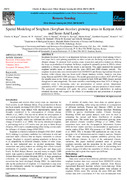| dc.contributor.author | Kigen, Charles | |
| dc.contributor.author | Ochieno, Dennis | |
| dc.contributor.author | Muoma, John | |
| dc.contributor.author | Shivoga, William | |
| dc.contributor.author | Konje, Martha | |
| dc.contributor.author | Onyando, Zedekiah | |
| dc.contributor.author | Soi, Benard | |
| dc.contributor.author | Makindi, Stanley | |
| dc.contributor.author | Kisoyan, Philip | |
| dc.contributor.author | Mironga, John | |
| dc.date.accessioned | 2019-05-06T11:55:18Z | |
| dc.date.available | 2019-05-06T11:55:18Z | |
| dc.date.issued | 2014-01-10 | |
| dc.identifier.issn | 2067420678 | |
| dc.identifier.uri | https://www.elixirpublishers.com/articles/1389362253_66%20(2014)%2020674-20678.pdf | |
| dc.identifier.uri | http://erepository.kibu.ac.ke/handle/123456789/850 | |
| dc.description.abstract | Sorghum (Sorghum bicolor) is an important African cereal crop and is listed among Africa’s lost crops but is now gaining popularity as other cereals are declining in production due to climatic change. To promote food security, many researchers and policy makers are shifting the focus on production of sorghum. In Kenya, sorghum is primarily grown in ASALs whose suitability is climatic factors but the extent is not known. This paper modeled the potential sorghum suitable areas of current and the years 2050 and 2080 climatic periods. The sorghum location data were downloaded from GENESYS and Kenya Agricultural Research Institute while climate data was from world climate database website. Analysis was done using Maxent and DIVA-GIS softwares. The model generated an excellent AUC of 0.97 and the suitable areas in the future are shown to expand in both 2050 and 2080 climatic periods though not in same magnitude. The main variables contributing more than 10 % of change in suitability areas in decreasing order are precipitation of wettest period, temperature seasonality (STD * 100), precipitation of warmest quarter, and precipitation of driest month. The generated information will guide the policy makers and stakeholders in making informed decisions with regard to the efforts of re-introduction and promotion of sorghum production in ASALs. | en_US |
| dc.language.iso | en | en_US |
| dc.publisher | Elixirpublishers : Agriculture | en_US |
| dc.rights | Attribution-NonCommercial-ShareAlike 3.0 United States | * |
| dc.rights.uri | http://creativecommons.org/licenses/by-nc-sa/3.0/us/ | * |
| dc.subject | Sorghum bicolor | en_US |
| dc.subject | Climate change | en_US |
| dc.subject | Maxent | en_US |
| dc.subject | DIVA-GIS | en_US |
| dc.subject | Spatial modeling | en_US |
| dc.subject | ASALs | en_US |
| dc.title | Spatial modeling of sorghum (sorghum bicolor) growing areasin Kenyan arid and semi-arid lands | en_US |
| dc.type | Article | en_US |

